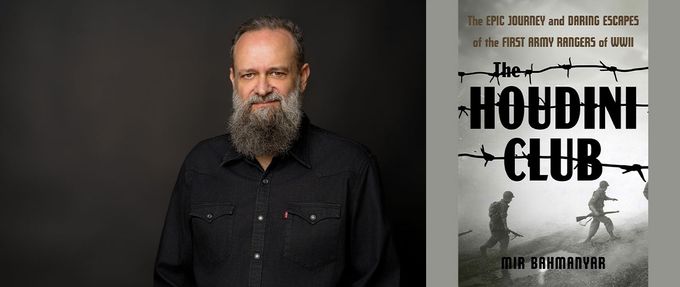The first unit of U.S. Army Rangers to see action during World War II endured brutal combat across North Africa and Italy, made daring escape attempts from prisoner-of-war camps that succeeded against all odds, and helped liberate Europe. They were Darby’s Rangers, named for William Orlando Darby, the founding commander of the First Ranger Battalion. They were also nicknamed “The Houdini Club” for their legendary ability to escape the horrors of Axis POW camps.
The men of this brave regiment are the focal point of Mir Bahmanyar’s new book, The Houdini Club. A former Army Ranger himself, he captures the lives and actions of Darby’s Rangers as they harnessed their elite skills during a highly destructive war. We had the opportunity to ask Mr. Bahmanyar several questions about Darby’s Rangers and his book, which Publishers Weekly called “a propulsive account” that “will enthrall WWII history buffs”.
Can you give us a broad overview of the POW escapes that led to the nickname “Houdini Club”, and how the Rangers’ skills were uniquely suited for these daring escapes?
Hundreds of Rangers were captured in the immediate aftermath of the Battle of Cisterna, where the Rangers fought overwhelming German forces. Many of Darby’s men escaped or attempted to escape, draining German manpower from the fronts. Some, like Captain Charles Shunstrom, escaped almost immediately from temporary Italian POW camps. In his case, he pretended to be an Italian labourer and walked out after breaching the barbed wire enclosures. He spent months crossing Italy’s mountains during winter, fighting alongside partisans, before finally making it back to Allied lines.
Other Rangers escaped from the trains that carried them north to Germany. Some did so by breaching a small, sealed window reinforced by barbed wire. In one escape, a fellow Ranger was used as a battering ram to punch through the wire, allowing the men to climb out. Hanging onto the outside of the box car, they jumped off whenever possible, many travelling in pairs as they had been taught during training and combat. Many of the Rangers made it back to their lines having spent weeks or months hiding from or sabotaging the enemy along the way.
Ranger Carl Harrison Lehmann attempted several escapes while in German prison camps, finally making it west during the chaotic retreat of the Germans from the advancing Soviets.
One other Ranger, Clarence Goad, endured the worst of the horrors of war as he found his way back to the Allies after covering hundreds of kilometres on foot with little or no food, crossing Ukraine, Russia and Crimea.
Their training, but most importantly, their will to survive, was crucial during those challenging times. The hard training many had gone through coupled with their combat experiences prepared many for the hardships they suffered. The Ranger Houdini Club was filled with Rangers who had incredible stories of survival and escape.
How did Darby’s Rangers influence the outcome of World War II?
Darby's Rangers were the first Americans to fight in Europe and were the first to liberate a European city, Gela in Sicily. They were the spearhead of all American amphibious assaults from North Africa to Sicily and onto mainland Italy. Some participated in five such nighttime assaults. From the sea or on land they seized key strategic points vital to Allied military successes.
As the first units of US Army Rangers during World War II, how did Darby’s Rangers influence future generations of Rangers?
The First Ranger Battalion was composed of Americans from all walks of life. Many had endured economic hardships. The original 500 were selected out of 2,000 men. They received excellent training under the tutelage of the British Commandos. It was during this time Rangers learned what the body could endure. Tortuous road marches, training during the worst of weather conditions, amphibious and mountain terrain training honed them further.
Obstacle courses, log drills, bayonet drills and “Me and My Pal”—the buddy system—were learned in those early months and refined by the Rangers on the battlefield of the greatest war ever fought in human history. These training methods and experiences shaped the future training of all Rangers and remain the core of the 75th Ranger Regiment. Modern Rangers are well-versed in very similar training to that of Darby’s Rangers.
What inspired you to write this book?
I met a number of Darby’s Rangers throughout my life and many shared their stories. I also inherited Darby Ranger Jim Altieri’s personal collection. Years passed but eventually the refurbishment of the small US Rangers Museum in Carrickfergus, Northern Ireland (and my minor involvement) reminded me of my responsibility to finally tell their true, unvarnished stories.
What is one fact from your research that really surprised you?
Major William Orlando Darby, the original commander of the 1st Ranger Battalion, a West Pointer and musically inclined, stripped off his jacket and beat the snot out of a rebellious, loud-mouthed Ranger who challenged him to a fist-fight while they were stationed in North Africa.
With the 80th Anniversary of VE Day approaching, a lot of people will be reflecting on the aftermath and legacy of World War II. What is one thing that you wish everyone knew about the war and/or Darby’s Rangers?
In a rather naive or romantic way, I believe WWII was supposed to be fought to defeat totalitarian regimes in the name of human rights and democracy. The Rangers were on the forefront of this brutal peer-to-peer war and experienced the worst (and sometimes the best) of mankind—the war etched into their souls and affected many well into their later years.
Those sacrifices should be kept in mind today—they killed, died and suffered for democracy. 80 years on, I reflect on how we strayed from those core principles, to defeat totalitarianism to help democracies. We are no longer the beacon for democracy in the world, something we had established in the immediacy of WWII.
This interview has been lightly edited for clarity.

